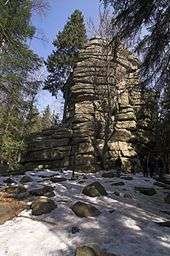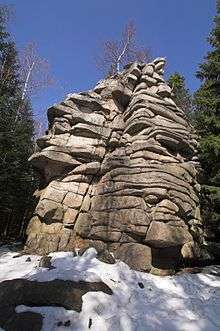Schnarcherklippen
Schnarcherklippen is the name of a rock formation (up to 671 m above sea level) south of the village of Schierke in the High Harz mountains of Saxony-Anhalt in central Germany. The name translates roughly to "snoring crags" or "snoring rocks".


Geology
The two rock pinnacles, which stand about 20 metres (66 ft) apart and are some 25 metres (82 ft) high, are part of the granite massif of the Brocken and are a clear example of spheroidal weathering" (Wollsackverwitterung).[1][2][3] Another feature of the Schnarcherklippen is that they deflect compass needles away from magnetic north due to the presence of magnetite in the rock.[4]
Access
The shortest way to the Schnarcherklippen rocks is by footpath from the Schierke. From the top of the rocks there is a view over the whole of the surrounding area, including the Bärenkopf, the holiday resort of Schierke, the Erdbeerkopf, the Brocken massif and the Wurmberg. The Schnarcherklippen are checkpoint no. 14 in the Harzer Wandernadel hiking trail network.[5]
Climbing
The northeastern pinnacle may be ascended using an iron ladder, but the southwestern rocks are only accessible to climbers. There are various climbing routes of grades I to VIIIb (Saxon grading) on the southwestern rocks and from IV to IXc on the northeastern rocks.[1][3]
Name
When the wind blows from the southeast the rocks make a strange sound which was the inspiration for its name (schnarchen = "snoring").[1]
Goethe and the crags
On his third journey to the Harz in September 1784 Johann Wolfgang von Goethe visited the Schnarcherklippen.[1] They are mentioned in the Walpurgis Night scene of Faust I and in Faust II:
| Faust I | |
|---|---|
Seh die Bäume hinter Bäumen, |
See them swiftly changing places, |
| Faust II | |
|---|---|
Der Blocksberg bleibt ein gar bequem Lokal, |
|

See also
References
- "Schnarcherklippen". harz-sehenswuerdigkeiten.de. Retrieved 20 Nov 2010.
- "Schnarcherklippen und Elendstal, 671 m". Kompass Karten. Retrieved 20 Nov 2010.
- Matthias Mann (15 December 2000). "Schnarcherklippen". Bergsportverein Climbing Crocodiles e.V. Retrieved 20 Nov 2010.
- Die Schnarcherklippen at www.harzlife.de. Accessed on 23 Dec 2010.
- "(14) Schnarcherklippe". zukunft-harz.de. Retrieved 20 Nov 2010.
- Faust I: "XXI Walpurgis Night"; translated by Bayard Taylor
- Faust II, act II: "Classical Walpurgis Night, Pharsalian Fields"; translated by George Madison Priest